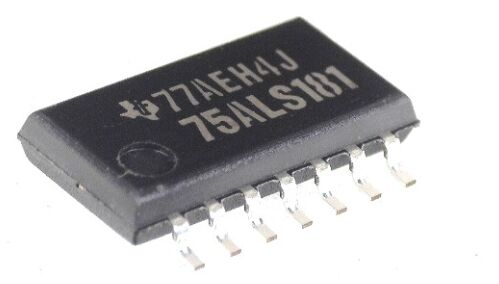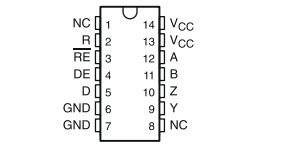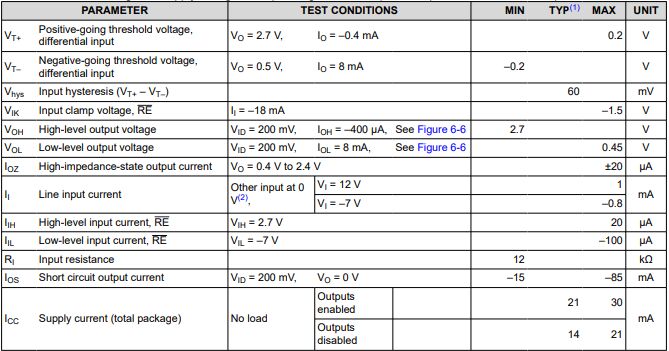By Texas Instruments 90
The SN75ALS181NSR is a differential driver and receiver pair designed for bidirectional data communication on multipoint bus transmission lines. It combines a three-state differential line driver and a differential input line receiver and is powered by a single 5V supply. In addition, this device complies with TIA/EIA-422-B, TIA/EIA-485-A and CCITT recommended V.10, V.11, X.26 and X.27 standards.
The SN75ALS181NSR is commonly used in differential signaling applications, such as in communications and data transmission systems. SN75ALS181NSR can effectively transmit high-speed differential signals and provide a certain degree of anti-interference capability, helping to ensure the reliability and stability of data transmission.

Ⅰ.Specification parameters of SN75ALS181NSR
Package:Reel
Number of pins:14
Drives/Packs:1
Function:Transceiver
Number of exciters:1 Driver
Number of receivers:1 Receiver
Series:SN75ALS181
Installation style:SMD/SMT
Package/Case:SOIC-14
Product Category:RS-422/RS-485 Interface IC
Data rate:10 Mb/s
Supply voltage-Max:5 V
Supply voltage-Minimum:5 V
Minimum operating temperature:0℃
Maximum operating temperature:+70℃
Number of pins:14
Height:1.95mm
Length:10.3 mm
Width:5.3 mm
Duplex:Full Duplex
Working power supply voltage:5 V
Working power current:30 mA
Number of channels:1 Channel
Trademark:Texas Instruments
Installation method:Surface Mount
Product type:RS-422/RS-485 Interface IC
Ⅱ.Features of SN75ALS181NSR
1.Anti-interference ability: SN75ALS181NSR has a certain anti-interference ability, which can reduce the impact of external interference on signal transmission and improve the reliability of the system.
2.ESD protection: The chip has electrostatic discharge (ESD) protection function and can provide protection for input and output.
3.Differential signal transmission: SN75ALS181NSR is specially designed for differential signal transmission and is suitable for applications requiring high-speed and high-stability transmission.
4.Low power consumption: SN75ALS181NSR has low power consumption characteristics when working, which helps to save system energy.
5.Wide operating voltage range: The device can operate normally under a wide range of operating voltage and has certain power supply adaptability.
6.High-speed transmission: This device can support high-speed transmission, helping to achieve fast data transmission rates in data transmission systems.
7.Programmable I/O voltage: SN75ALS181NSR has programmable I/O voltage levels, and different voltages can be set according to system requirements.
8.Internal protection function: SN75ALS181NSR usually contains internal over-voltage and over-current protection functions to protect the device from damage to the external environment.
9.Industrial temperature range: SN75ALS181NSR is usually able to work normally within the industrial temperature range and is suitable for applications in industrial environments.
10.Comply with multiple standards: The device complies with TIA/EIA-422-B, TIA/EIA-485-A and the V.10, V.11, X.26 and X.27 standards recommended by CCITT, and has good compatibility performance and interoperability.
11.Differential input and differential output: Differential signal transmission has better anti-interference performance, making SN75ALS181NSR suitable for data transmission in noisy environments.
Ⅲ.Configure the enabling end of SN75ALS181NSR to control the communication direction
First, you need to use two enable terminals: DE (data enable) and RE (receive enable). These two enable terminals allow control of the operation of the differential driver (transmit) and differential receiver (receive).
Configuration steps:
1.Connect power and ground: First, make sure you connect VCC (power) to an appropriate positive power supply (usually +5V) and VEE (ground) to ground.
2.Set the DE (data enable) terminal:
•When DE is low (usually VEE or 0V), the differential driver is disabled, the output is high-impedance, and no data is sent.
•When DE is high (usually VCC), the differential driver is activated, allowing data to be sent from the driver onto the transmission line.
3.Set the RE (receive enable) terminal:
•When RE is low (usually VEE or 0V), the differential receiver is disabled and the output is high impedance.
•When RE is high (usually VCC), the differential receiver is activated, allowing data to be received from the transmission line.
4.Select communication mode:
•Transmit mode: Set DE to high level and RE to low level. At this time, data is sent from the driver of SN75ALS181NSR to the transmission line.
•Receive mode: Set DE to low level and RE to high level. At this time, data is received from the transmission line and output to the receiver of the SN75ALS181NSR.
5.Connect the transmission lines: Use an appropriate differential transmission line (such as a twisted pair) to connect the Y output (driver output) of the SN75ALS181NSR to the input of the receiving device, and connect the output of the sending device to the A and B inputs of the SN75ALS181NSR (receiver enter).
6.Microcontroller control: In more complex systems, DE and RE can be controlled through the GPIO (General Purpose Input/Output) pins of the microcontroller. In this way, the communication direction can be dynamically switched through programming.
Ⅳ.Pin Configuration and Functions of SN75ALS181NSR

•Pin1,8(No Connect):Not electrically connected
•Pin2(Digital Output):Logic output RS485 data
•Pin3(Digital Input):Receiver enable, active low
•Pin4(Digital Input):Driver enable, active high
•Pin5(Digital Input):Driver data input
•Pin6,7(Ground):Device ground
•Pin9(Bus Output):Bus Output Y (Complementary to Z)
•Pin10(Bus Output):Bus Output Z (Complementary to Y)
•Pin11(Bus Input):Bus Input B (Complementary to A)
•Pin12(Bus Input):Bus Input A (Complementary to B)
•Pin13,14(Power):5 V Supply
Ⅴ.Absolute Maximum Ratings of SN75ALS181NSR
over operating free-air temperature range (unless otherwise noted) see

Ⅵ.Application fields of SN75ALS181NSR
1.Computer peripherals: In the design of computer peripherals, such as USB interface, RS-485 interface, etc., SN75ALS181NSR can be used for data transmission and communication control.
•In USB interface design, SN75ALS181NSR can be used as a driver/receiver for USB 2.0 high-speed signal transmission. The USB 2.0 specification uses differential signaling technology, which matches the capabilities of the SN75ALS181NSR. This device can help realize high-speed data transmission of the USB interface and ensure signal stability and accuracy.
•RS-485 is a differential serial communication protocol widely used in industrial automation, remote monitoring and data acquisition and other fields. The differential signaling characteristics of the SN75ALS181NSR make it an ideal choice for RS-485 interface designs. Through this device, multi-point communication on the RS-485 bus can be realized, with long transmission distance and high anti-interference ability.
•In addition to USB and RS-485 interfaces, SN75ALS181NSR can also be used in the design of other computer peripherals, such as Ethernet interfaces, parallel interfaces, etc. In these application scenarios, the device can provide stable and reliable differential signal transmission, thereby ensuring data accuracy and transmission reliability.
2.Medical equipment: In medical equipment, SN75ALS181NSR can be used to transmit biosensor data, medical image data, etc. to ensure the accuracy and security of the data. As a high-speed, low-power consumption, differential signal transmission device, SN75ALS181NSR is very suitable for data transmission in medical equipment.
•In medical devices, biosensors are used to monitor physiological parameters of patients such as heart rate, blood pressure, blood sugar, etc. SN75ALS181NSR can be used for data transmission between biosensors and medical equipment hosts to ensure data accuracy and real-time performance. Differential signaling reduces interference and noise, thereby improving data reliability.
•Medical image data, such as X-ray, MRI, ultrasound, etc., are an important basis for doctors to make diagnosis. This data usually needs to be transmitted to the display or data center at high speed and stably. The SN75ALS181NSR's high-speed performance and differential signaling technology make it ideal for medical image data transmission. By using this device, the integrity and accuracy of medical image data can be ensured, thereby improving the accuracy and efficiency of diagnosis.
•In medical equipment, data security is also very important. The SN75ALS181NSR can help achieve data encryption and transmission security, thereby protecting patient privacy and the security of medical data. In addition, the device also features low power consumption, which helps extend the battery life of medical equipment and reduce the frequency of maintenance and replacement.
3.Industrial automation: In factory automation systems, SN75ALS181NSR can be used to transmit sensor data, control signals and monitoring signals to ensure the reliability and stability of signal transmission.
•In industrial automation, various sensors are used to monitor the status of production lines, such as temperature, pressure, flow, etc. SN75ALS181NSR can be used for data transmission between sensors and control systems to ensure data accuracy and real-time performance. Differential signaling technology reduces electrical noise and interference, thereby increasing the reliability of sensor data.
•Monitoring signals are used to monitor the operating status of the production line in real time to ensure the safety and stability of the production process. SN75ALS181NSR can be used to monitor signal transmission to help operators detect and deal with potential problems in a timely manner. Through high-speed and stable signal transmission, the accuracy and real-time performance of the monitoring system can be ensured.
•Control signals are important information used to drive actuators (such as motors, valves, etc.) in industrial automation systems. SN75ALS181NSR can provide fast and stable control signal transmission to ensure that the actuator can accurately execute control instructions. This helps achieve precise control and efficient operation of the production line.
•Industrial automation systems require a high degree of reliability and stability to ensure the continuous operation of the production line and the stability of product quality. SN75ALS181NSR has excellent anti-interference ability and stability, and can work stably in harsh industrial environments, thereby improving the overall reliability and stability of industrial automation systems.
4.Instrumentation: In measurement and instrumentation equipment, SN75ALS181NSR can be used for signal transmission and reception. It can be used in high-precision measurement equipment, providing differential signal transmission to reduce signal interference and improve measurement accuracy.
5.Data acquisition system: In the data acquisition and transmission system, SN75ALS181NSR can be used to transmit sensor data to the control center or data processing unit. It can be used in remote data acquisition systems to ensure data accuracy and reliability through differential signal transmission.
6.Server: SN75ALS181NSR can be used for high-speed data transmission and sending and receiving. It can be used to expand the I/O interface of a computer or server and provide high-speed, stable differential signal transmission. As a differential driver and receiver, the SN75ALS181NSR provides excellent differential signal transmission performance. During high-speed data transmission, differential signal transmission can effectively resist noise and interference, ensuring data integrity and accuracy. This makes the SN75ALS181NSR play a vital role in the server, providing stable and reliable data transmission support for the server.
7.Automotive electronics: In automotive electronic systems, SN75ALS181NSR can be used to transmit vehicle sensor data, control signals, etc. to ensure the stability and reliability of automotive electronic systems.
•In automotive electronic systems, various sensors continuously monitor vehicle status, such as vehicle speed, engine temperature, air pressure, etc. This data needs to be transmitted quickly and accurately to a central control unit for analysis and processing. The high-speed and stable differential signal transmission provided by SN75ALS181NSR can effectively ensure the accurate transmission of vehicle sensor data and provide key information for the stable operation of the vehicle.
•Control signals in automotive electronic systems are key to ensuring that vehicle components work as expected. These control signals need to be transmitted quickly and accurately to various actuators, such as engines, braking systems, steering systems, etc. The high-speed transmission capability and stable differential signal output of the SN75ALS181NSR make it an ideal choice for transmitting control signals to ensure coordinated work among various vehicle components.
•The stability and reliability of automotive electronic systems are critical to vehicle safety and performance. The differential signal transmission technology of SN75ALS181NSR can effectively resist electromagnetic interference and electrical noise, ensuring the stability and reliability of data transmission in complex automotive environments. In addition, its high performance and low power consumption design also help improve the overall performance and life of automotive electronic systems.
8.Communication: In network equipment and communication systems, SN75ALS181NSR can be used for high-speed data transmission, such as Ethernet, optical fiber communication, etc., to ensure high speed and low bit error rate of data transmission.
Ⅶ.How does SN75ALS181NSR reduce electromagnetic interference?
1.Differential signaling: SN75ALS181NSR uses differential signaling technology, which means it sends two complementary signals at the same time. This transmission method is more robust to electromagnetic interference, since interference usually affects both signals at the same time, but since they are complementary, the receiver can easily identify and cancel these interferences.
2.Common mode suppression: Common mode interference is a common form of electromagnetic interference that affects both signals in a differential pair at the same time. SN75ALS181NSR has strong common-mode suppression capability, which can effectively suppress this interference and ensure the accuracy and stability of data transmission.
3.Noise suppression circuit: SN75ALS181NSR integrates noise suppression circuits. These circuits can identify and filter out noise caused by electromagnetic interference. This helps maintain signal clarity and accuracy, maintaining stable data transmission even in environments with strong electromagnetic interference.
4.Optimize PCB layout: In electronic equipment, the layout of PCB (printed circuit board) has a great impact on electromagnetic interference. The effects of electromagnetic interference can be reduced by placing the SN75ALS181NSR away from potential sources of interference, such as high-frequency clocks or power lines, and by minimizing long runs of signal lines.
5.Proper grounding and shielding: Various measures have been taken inside the SN75ALS181NSR to reduce electromagnetic interference, but proper grounding and shielding are still the key to reducing external interference. The effects of electromagnetic interference on the SN75ALS181NSR can be further reduced by ensuring that the device is properly grounded and using appropriately shielded cables and connectors.
Ⅷ.Electrical Characteristics: Receiver of SN75ALS181NSR
over recommended ranges of supply voltage and operating free-air temperature (unless otherwise noted)

Frequently Asked Questions
1.What are the key features of SN75ALS181NSR?
SN75ALS181NSR features high-speed, high-accuracy, and strong noise immunity for reliable differential signal transmission.
2.What are some key specifications of SN75ALS181NSR?
Key specifications include operating voltage range, data transfer rate, input/output impedance, and temperature range.
3.How does SN75ALS181NSR contribute to system reliability?
SN75ALS181NSR contributes to system reliability by ensuring accurate and stable signal transmission, even in challenging environments.